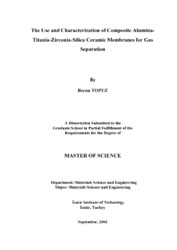Please use this identifier to cite or link to this item:
https://hdl.handle.net/11147/3468| Title: | The Use and Characterization of Composite Alumina-Titania Membranes for Gas Separation | Authors: | Topuz, Berna | Advisors: | Çiftçioğlu, Muhsin | Publisher: | Izmir Institute of Technology | Abstract: | The preparation, characterization and pure gas permeation of sol-gel derived alumina and silica membranes were investigated in this work. The effects of various parameters on sol particle size and unsupported membranes pore structure were investigated by laser light scattering particle size and N2 adsorption-desorption analysis .-alumina membranes were prepared on ZrO2 supports by successive dipping into boehmite sols. Almost proportional decreases in sol particle size and membrane pore diameter were determined with increasing acid content during the boehmite sol preparation. Increasing the H+/Al3+ mole ratio from 0.1 to 0.25 caused the hydrodynamic particle size and BJH pore size to decrease from 65 to 30 nm and 3.6 to 2.9 nm, respectively. The pore size increased from 2.8 nm to 3 nm upon increasing the calcination temperature from 500 to 600oC. Unsupported membranes were heat treated in the 200 to 1200 oC range for the characterization of the phase structure. Boehmite was the dominant phase below 500 oC, gamma being the dominant phase up to 900 oC and pure .-Al2O3 phase was obtained upon heat treatment at 1200oC. Pinhole and crack free alumina membranes about 3 .m (double layer) in thickness were observed from SEM pictures with insignificant infiltration. The CO2 permeability through the double layer .-Al2O3 membrane calcined at 600 oC was about 2.25*10-7 mol/m2.s.Pa, and had a slight pressure dependence which may indicate Knudsen Diffusion and Laminar Flow as the effective transport mechanisms. Upon the calcination of a similar double layer alumina membrane at 500oC, the CO2 permeability decreased to 1.51*10-8 mol/m2.s.Pa and was independent of pressure. Silica membranes were prepared by a sol-gel technique. These sols were prepared by acid catalysed hydrolysis and condensation of tetraethylorthosilicate in the presence of a solvent. The effects of processing parameters like the acid type and amount utilized during sol preparation, sol aging, heat treatment conditions, dipping time on the membrane pore structure and the permeation of pure gases were investigated. The supported membranes were heat treated in the 50-400 oC range. The N2 and CO2 permeabilities of silica membranes varied in the 2.2 * 10-10 . 2.7 * 10-8 mol / m2.s.Pa and 1.2*10-9 . 6.95*10-8 mol / m2.s.Pa range for single layer membranes dipped for 10 seconds into the sol. The sols became viscous and gelled in 16 hours at 50 oC. The O2 permeability increased with aging time. The optimum dipping time during processing was determined to be 10 seconds. The permeabilities of these membranes increased significantly with the sol acid content. The thickness of the silica membranes were determined to be about 2.m and significant infiltration into the support was observed from the SEM pictures. | Description: | Thesis (Master)--Izmir Institute of Technology, Materials Science and Engineering, Izmir, 2002 Includes bibliographical references (leaves: 120-124) Text in English; Abstract: Turkish and English x, 124 leaves |
URI: | http://hdl.handle.net/11147/3468 |
| Appears in Collections: | Master Degree / Yüksek Lisans Tezleri |
Files in This Item:
| File | Description | Size | Format | |
|---|---|---|---|---|
| T000298.pdf | MasterThesis | 5.26 MB | Adobe PDF |  View/Open |
CORE Recommender
Page view(s)
356
checked on Apr 28, 2025
Download(s)
230
checked on Apr 28, 2025
Google ScholarTM
Check
Items in GCRIS Repository are protected by copyright, with all rights reserved, unless otherwise indicated.